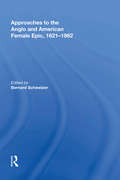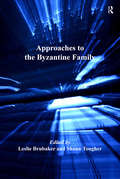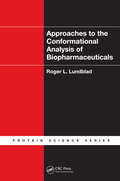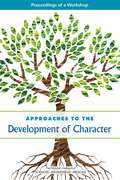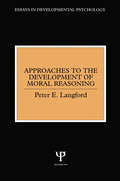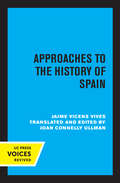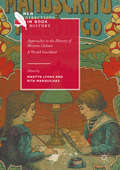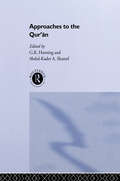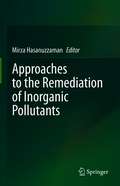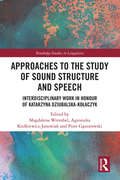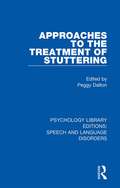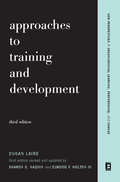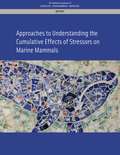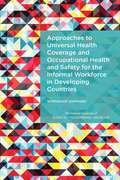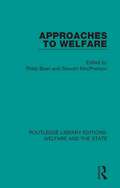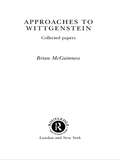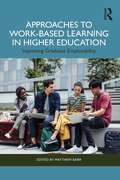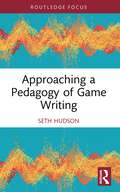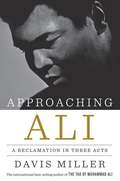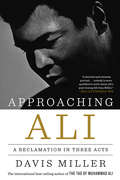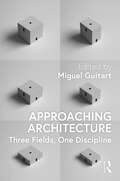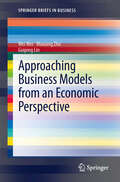- Table View
- List View
Approaches to the Anglo and American Female Epic, 1621-1982
by Bernard SchweizerEpic has long been regarded as the exclusive domain of the male literary genius and as an incarnation of patriarchal values. This provocative collection of essays challenges such a hegemonic stereotype by demonstrating the ways in which women writers have successfully adapted the masculine epic tradition to suit their own aesthetic needs and to express their own heroic literary, social, and historical visions. Bringing the female epic out of the shadows, the contributors rethink generic boundaries to illuminate this heretofore hidden literary practice. The essays range from Mary Tighe to Rebecca West from Elizabeth Barrett Browning to Gwendolyn Brooks, and from Frances Burney to Virginia Woolf. Bernard Schweizer's introduction, titled 'Muses with Pens,' connects the trajectory of ideas and influences in the individual essays to demonstrate how each participates in reclaiming for women writers a place in the development of a female epic tradition. The volume will be an invaluable resource for scholars working on issues related to genre, canon formation, and the evolution of female literary authority.
Approaches to the Byzantine Family (Birmingham Byzantine and Ottoman Studies #14)
by Leslie Brubaker Shaun TougherThe study of the family is one of the major lacunas in Byzantine Studies. Angeliki Laiou remarked in 1989 that ’the study of the Byzantine family is still in its infancy’, and this assertion remains true today. The present volume addresses this lacuna. It comprises 19 chapters written by international experts in the field which take a variety of approaches to the study of the Byzantine family, and embrace a chronological span from the later Roman to the late Byzantine empire. The context is established by chapters focusing on the Roman roots of the Byzantine family, the Christianisation of the family, and the nature of the family in contemporaneous cultures (the late antique west and the Islamic east). Key methodological approaches to the Byzantine family are highlighted and discussed, in particular prosopographical and life course approaches. The contribution of hagiography to the understanding of the Byzantine family is analysed by several authors; other chapters on the family and children in art and on the archaeology of the Middle Byzantine house explore the material evidence that can shed light on the Byzantine family. Overall, the diversity of families that existed in Byzantium (blood, fictive, metaphorical) is emphasised, and chapters consider the specific cases of ascetic, monastic, aristocratic and peasant families, as well as the imperial family, which is illuminated by the comparative case of a Caliphal family. The volume is topped and tailed by a Preface and an Afterword by the editors, which address the state of the field and consider the way ahead. Thus the volume is vital in putting the subject of the Byzantine Family in sharp focus and setting the research agenda for the future.
Approaches to the Conformational Analysis of Biopharmaceuticals (Protein Science)
by Roger L. LundbladThe activity of many biopharmaceutical polymers is dependent on conformation, and the next several years will see increased interest in the conformational analysis of these polymers resulting from the development of biosimilar or "follow-on" biological products. While a wide variety of approaches to analysis exists, finding the most viable ones wou
Approaches to the Development of Character: Proceedings of a Workshop
by National Academies of Sciences Engineering MedicineThe development of character is a valued objective for many kinds of educational programs that take place both in and outside of school. Educators and administrators who develop and run programs that seek to develop character recognize that the established approaches for doing so have much in common, and they are eager to learn about promising practices used in other settings, evidence of effectiveness, and ways to measure the effectiveness of their own approaches. In July 2016, the National Academies of Sciences, Engineering, and Medicine held a workshop to review research and practice relevant to the development of character, with a particular focus on ideas that can support the adults who develop and run out-of-school programs. This publication summarizes the presentations and discussions from the workshop.
Approaches to the Development of Moral Reasoning (Essays in Developmental Psychology)
by Peter E. LangfordThe first part of the book offers a survey of current approaches to the development of moral reasoning: those of Freud, ego psychology, Piaget and Kohlberg. The approach of Kohlberg has been popular because he was able to give an impressive account of findings from the key method of interviews, the other crucial method being naturalistic observation of moral discourse. The accounts of interview evidence given by ego psychology and Piaget were less comprehensive and less impressive. Naturalistic studies have either been impressionistic or less detailed in their methods of analysis.The second part of the book argues that the impressive nature of Kohlberg's later evidence for his view that moral reasoning passes through a sequence of stages is in part illusory, because his theory predicts that specific types of reply will show specific developmental patterns. However, as data are always reported in terms of stages, which amalgamate very disparate types of reply, it is impossible to know whether the specific types of reply follow their predicted developmental courses or not. Reasons given for assigning given types of reply to a stage are also often doubtful. This leads to discussion of studies that have reported findings in terms of specific types of reply (weakly interpretive methods), as opposed to Kohlberg's stage-based and strongly interpretive methods. Findings from these disconfirm Kohlberg's theory at several crucial points.The second and third parts of the book also examine findings from non-Kohlbergian interviews and other methods, again advocating that weakly interpretive and largely descriptive presentation of findings is preferable to strongly interpretive techniques. It is argued that a wide variety of mechanisms suggested by the theories outlined in the first part of the book, as well as others drawn from general theories of personality development, are able to explain existing descriptive developmental findings. The task for the future is to assess the relative importance of these mechanisms.
Approaches to the Evolution of Language: Language in Prehistory
by Alan BarnardFor ninety per cent of our history, humans have lived as 'hunters and gatherers', and for most of this time, as talking individuals. No direct evidence for the origin and evolution of language exists; we do not even know if early humans had language, either spoken or signed. Taking an anthropological perspective, Alan Barnard acknowledges this difficulty and argues that we can nevertheless infer a great deal about our linguistic past from what is around us in the present. Hunter-gatherers still inhabit much of the world, and in sufficient number to enable us to study the ways in which they speak, the many languages they use, and what they use them for. Barnard investigates the lives of hunter-gatherers by understanding them in their own terms, to create a book which will be welcomed by all those interested in the evolution of language.
Approaches to the Evolution of Language: Language Evolution
by Rudolf BothaHow can we unravel the evolution of language, given that there is no direct evidence about it? Rudolf Botha addresses this intriguing question in his fascinating new book. Inferences can be drawn about language evolution from a range of other phenomena, serving as windows into this prehistoric process. These include shell-beads, fossil skulls and ancestral brains, modern pidgin and creole languages, homesign systems and emergent sign languages, modern motherese, language use of modern hunter-gatherers, first language acquisition, similarities between language and music, and comparative animal behaviour. The first systematic analysis of the Windows Approach, it will be of interest to students and researchers in many disciplines, including anthropology, archaeology, linguistics, palaeontology and primatology, as well as anyone interested in how language evolved.
Approaches to the History of Spain
by Jaime Vicens VivesThis title is part of UC Press's Voices Revived program, which commemorates University of California Press’s mission to seek out and cultivate the brightest minds and give them voice, reach, and impact. Drawing on a backlist dating to 1893, Voices Revived makes high-quality, peer-reviewed scholarship accessible once again using print-on-demand technology. This title was originally published in 1970.
Approaches to the History of Written Culture: A World Inscribed (New Directions in Book History)
by Martyn Lyons Rita MarquilhasThis book investigates the history of writing as a cultural practice in a variety of contexts and periods. It analyses the rituals and practices determining intimate or 'ordinary' writing as well as bureaucratic and religious writing. From the inscribed images of 'pre-literate' societies, to the democratization of writing in the modern era, access to writing technology and its public and private uses are examined. In ten studies, presented by leading historians of scribal culture from seven countries, the book investigates the uses of writing in non-alphabetical as well as alphabetical script, in societies ranging from Native America and ancient Korea to modern Europe. The authors emphasise the material characteristics of writing, and in so doing they pose questions about the definition of writing itself. Drawing on expertise in various disciplines, they give an up-to-date account of the current state of knowledge in a field at the forefront of 'Book History'.
Approaches to the Qur'an (SOAS/Routledge Studies on the Middle East)
by G. R. Hawting Abdul-Kader A. ShareefIn recent years, the study of the Qur'an and its interpretation has expanded to incorporate insights gained from historical, biblical, literary and critical studies. A variety of approaches to the Qur'an and the Muslim exegetical tradition are currently available. Approaches to the Qur'an consists of thirteen essays by leading scholars, both Muslim and non-Muslim, in the fields of qur'anic studies and Islamic studies. Taken together, they offer a sample of the aims, methods and topics of enquiry now being pursued. Each study has a full critical apparatus, and the book includes a consolidated bibliography which will be of great value to students and specialists.
Approaches to the Remediation of Inorganic Pollutants
by Mirza HasanuzzamanIn this comprehensive book, plant biologists and environmental scientists present the latest information on different approaches to the remediation of inorganic pollutants. Highlighting remediation techniques for a broad range of pollutants, the book offers a timely compilation to help readers understand injury and tolerance mechanisms, and the subsequent improvements that can be achieved by plant-based remediation. Gathering contributions by respected experts in the field, the book represents a valuable asset for students and researchers, particularly plant physiologists, environmental scientists, biotechnologists, botanists, soil chemists and agronomists.
Approaches to the Study of Sound Structure and Speech: Interdisciplinary Work in Honour of Katarzyna Dziubalska-Kołaczyk (Routledge Studies in Linguistics)
by Magdalena Wrembel Agnieszka Kiełkiewicz-Janowiak Piotr GąsiorowskiThis innovative work highlights interdisciplinary research on phonetics and phonology across multiple languages, building on the extensive body of work of Katarzyna Dziubalska-Kołaczyk on the study of sound structure and speech. // The book features concise contributions from both established and up-and-coming scholars who have worked with Katarzyna Dziubalska-Kołaczyk across a range of disciplinary fields toward broadening the scope of how sound structure and speech are studied and how phonological and phonetic research is conducted. Contributions bridge the gap between such fields as phonological theory, acoustic and articulatory phonetics, and morphology, but also includes perspectives from such areas as historical linguistics, which demonstrate the relevance of other linguistic areas of inquiry to empirical investigations in sound structure and speech. The volume also showcases the rich variety of methodologies employed in existing research, including corpus-based, diachronic, experimental, acoustic and online approaches and showcases them at work, drawing from data from languages beyond the Anglocentric focus in existing research. // The collection reflects on Katarzyna Dziubalska-Kołaczyk’s pioneering contributions to widening the study of sound structure and speech and reinforces the value of interdisciplinary perspectives in taking the field further, making this key reading for students and scholars in phonetics, phonology, sociolinguistics, psycholinguistics, and speech and language processing.
Approaches to the Treatment of Stuttering (Psychology Library Editions: Speech and Language Disorders)
by Peggy DaltonIn the years prior to publication ‘cures’ for stuttering seemed to appear constantly, but many were of limited value, were poorly evaluated and gave only a temporary alleviation that was not transferred to daily life. More responsible clinicians produced publications expounding one particular approach to therapy but less was available giving a balanced overview which was of practical help to therapists. Originally published in 1983, this book aimed to provide such an overview, with a focus on practical intervention rather than on theory. The need for careful assessment is particularly stressed and also the need for flexibility in the choice of treatment for any one client. Changes in fluency are looked at in relation to the effects they might have on the person’s life as a whole and factors involved in the maintenance of this change are discussed. In addition, adjuncts to speech therapy, such as drugs, hypnosis and various forms of masking are evaluated. Issues of the training of therapists are raised and suggestions made as to the nature of the therapeutic relationship when working with people who stutter.
Approaches To Training And Development: Third Edition Revised And Updated (New Perspectives In Organizational Learning, Performance, And Change Ser.)
by Dugan Laird Elwood F. Holton Sharon NaquinApproaches to Training and Development provides a comprehensive and practical introduction to the field of organizational training and human-resource development. It surveys the methods, functions, and goals of training--from needs assessment to implementation--illustrating each step of an effective training program. This new edition includes updates throughout, with fresh examples and current references, with an emphasis on evaluating and explaining new training. Comprehensive, authoritative, and accessible, this new edition will prove an essential resource to a new generation of trainers, HRD professionals, educators, and managers.
Approaches to Understanding the Cumulative Effects of Stressors on Marine Mammals
by Engineering Medicine National Academies of SciencesMarine mammals face a large array of stressors, including loss of habitat, chemical and noise pollution, and bycatch in fishing, which alone kills hundreds of thousands of marine mammals per year globally. To discern the factors contributing to population trends, scientists must consider the full complement of threats faced by marine mammals. Once populations or ecosystems are found to be at risk of adverse impacts, it is critical to decide which combination of stressors to reduce to bring the population or ecosystem into a more favorable state. Assessing all stressors facing a marine mammal population also provides the environmental context for evaluating whether an additional activity could threaten it. Approaches to Understanding the Cumulative Effects of Stressors on Marine Mammals builds upon previous reports to assess current methodologies used for evaluating cumulative effects and identify new approaches that could improve these assessments. This review focuses on ways to quantify exposure-related changes in the behavior, health, or body condition of individual marine mammals and makes recommendations for future research initiatives.
Approaches to Universal Health Coverage and Occupational Health and Safety for the Informal Workforce in Developing Countries: Workshop Summary
by National Academies of Sciences Engineering MedicineUniversal health coverage (UHC) has been recognized by the World Health Organization as a key element in reducing social inequality and a critical component of sustainable development and poverty reduction. In most of the world UHC is sought through a combination of public and private-sector health care systems. In most low- and middle-income countries health systems are evolving to increasingly rely on the private sector because the public sector lacks the infrastructure and staff to meet all health care needs. With growing individual assets available for private-sector expenditure, patients often seek better access to technology, staff, and medicines. However, in low-income countries nearly 50 percent of health care financing is out-of-pocket. With the expected increase in the overall fraction of care provided through the private sector, these expenditures can be financially catastrophic for individuals in the informal workforce. In the global workforce of approximately 3 billion people, only 10 to 15 percent are estimated to have some type of access to occupational health services. The informal workforce is growing worldwide, and the degree to which its occupational health needs are satisfied depends on the capabilities of the general health care system. In July 2014, the Institute of Medicine held a workshop on approaches to universal health coverage and occupational health and safety for informal sector workers in developing countries. This report summarizes the presentations and discussions from this workshop. Approaches to Universal Health Coverage and Occupational Health and Safety for the Informal Workforce in Developing Countries identifies best practices and lessons learned for the informal workforce in developing countries in the financing of health care with respect to health care delivery models that are especially suitable to meeting a population's needs for a variety of occupational health issues, including the prevention of or mitigation of hazardous risks and the costs of providing medical and rehabilitation services and other benefits to various types of workers within this population. These experiences and lessons learned may be useful for stakeholders in moving the discussions, policies, and mechanisms forward to increase equitable access to quality health services without financial hardship for the informal workforce.
Approaches to Welfare (Routledge Library Editions: Welfare and the State #1)
by Philip Bean Stewart MacphersonOriginally published in 1983 Approaches to Welfare provides a unique introduction to the study of social welfare in Britain. The contributions, by distinguished figures in the field of social welfare and social policy, explore all the dimensions of the study of social welfare demonstrating that not only have social policies changed in the forty years since the establishment of the welfare state, but so too have approaches to their analysis. The contributors consider these changes in relation to a wide range of social welfare issues, illuminating the diversity and variety within the contemporary study of social policy.
Approaches to Wittgenstein: Collected Papers
by Brian McGuinnessApproaches to Wittgenstein brings together for the first time the many varied aspects of Wittgenstein's life, philosophy, and aesthetic attitudes.
Approaches to Work-Based Learning in Higher Education: Improving Graduate Employability
by Matthew BarrApproaches to Work-Based Learning in Higher Education provides a comprehensive introduction to the delivery of university-level work-based learning (WBL) for educators and policymakers. The contributing authors draw from their wealth of experience of developing apprenticeships, placement programmes and other work-based learning opportunities, advising on best practice when delivering learning in partnership with industry.Supported by a unique balance of practical and theoretical insight, including international perspectives on how common challenges may be addressed, this essential volume explores the following key themes: Pedagogies – this section outlines established best practice in delivery of WBL for higher education and offers suggestions for how readers may continue to develop and improve their provision. Projects – this section covers a range of approaches to work-based learning within higher education and explores examples of this in practice, including live briefs, work placements and industrial project-based learning. Apprenticeships – this section focuses specifically on work-based degree programmes, covering their design, delivery, implementation and assessment. A must-read for anyone working within higher education policy or practice, this book provides readers with the tools to successfully navigate work-based learning, as well as strategies for ensuring and enhancing the quality of the learning experience.
Approaching a Pedagogy of Game Writing
by Seth HudsonThis book examines the practices of writers in the AAA video game industry, to provide a model for game writing pedagogy that highlights the roles and skills utilized by these innovative storytellers. Based on a two-year qualitative study, gathering data through conversational interviews, Seth Hudson combines theory, practice, and his experience as an educator-researcher to shed light on the phenomenon of game writing and writers who drive innovation in game storytelling. The author gives context for a range of audiences, examining the role of computer game design (CGD) in higher education, the role of writing and narrative design within those programs, the current and historical challenges game writers face, and the purpose of the research underpinning this book. Hudson frames a synthesis of research findings and relevant theory to illustrate new teaching practices informed by his findings that will help better serve students. This book will provide an essential resource for game studies and game design educators and researchers, as well as game narrative enthusiasts.
Approaching Ali: A Reclamation in Three Acts
by Davis MillerOn Easter weekend 1988, then struggling writer and movie store clerk Davis Miller drove to Muhammad Ali's mother's modest house in Louisville, knocked on the front door, and waited for an answer. It had been over two decades since he'd first glimpsed The Champ on a black-and-white television--when Miller was an eleven-year-old boy, shattered by the unexpected loss of his mother--and he felt the time had come for him to personally thank the man whose fearlessness, grace, and tenacity gave him the power to overcome a near-paralyzing depression. When the door finally opened, Miller would not only get to meet his "spiritual constant" but also begin a surprising and tender new friendship that would forever transform his life. Today, more than twenty-five years later, the two still share an uncommon bond, the sort that can be fashioned only in serendipitous ways and fortified through shared experiences. Miller now draws from those remarkable moments to give us a quietly startling portrait of a great man physically ravaged but spiritually young. Beginning with a series of three interconnected anecdotes about Miller's first meeting with the champ--which formed the basis of "My Dinner with Ali," a legendary piece of sports journalism that was anthologized in The Best American Sports Writing of the Century--Approaching Ali continues as a historic tribute, composed of linked vignettes spread out over decades, that is unlike anything else that has been written about one of the world's most famous and loved men. As readers will discover in these pages, Miller is the Everyman, Ali the Superman in physical decline. Commingled together, the two voices form the all-time most intimate portrait of Ali's day-by-day life in his postboxing career. Through Miller's eyes, we witness the aging and ailing Ali playing mischievous tricks on unsuspecting guests, performing sleight of hand for any willing audience, and walking over ten miles each day to enjoy an ice cream sundae and talk with strangers. Miller goes on to reveal a side of the boxing legend we never knew was there, whether it be Ali handing out hundred-dollar bills at a Los Angeles bus stop, showing a group of inner-city children the ocean for the very first time, or unexpectedly cracking jokes with the distinctly insightful words he is still able to summon. Following in the grand contemporary literary tradition of writers such as Gay Talese, Tom Wolfe, and Nick Hornby, Miller gives us a series of extraordinary insights into a man that he has been approaching nearly his entire life. The result is both a new introduction to the human side of a boxing legend as well as a loving and beautifully written reclamation of Muhammad Ali's life after the ring.
Approaching Ali: A Reclamation in Three Acts
by Davis MillerThe single most intimate look at Muhammad Ali’s retirement, told through the story of an unexpected, powerful and life-changing friendship In 1988, then struggling writer and video store worker Davis Miller drove to Muhammad Ali’s mother’s modest Louisville house, knocked on the door, and introduced himself to his childhood idol. Now, all these years later, the two friends have an uncommon bond, the sort that can be fashioned only in serendipitous ways and fortified through shared experiences. Miller draws from his remarkable moments with The Champ to give us a beautifully written portrait of a great man physically devastated but spiritually young—playing mischievous tricks on unsuspecting guests, performing sleight of hand for any willing audience, and walking ten miles each way to grab an ice cream sundae. Informed by great literary journalists such as Joan Didion, Tom Wolfe, and Gay Talese, but in a timeless style that is distinctly his own, Miller gives us a series of extraordinary stories that coalesce into an unprecedentedly humanizing, intimate, and tenderly observed portrait of one of the world’s most loved men.
Approaching Architecture: Three Fields, One Discipline
by Miguel GuitartThe study of the architectural discipline suffers from an increasing disconnect between its teaching and its professional practice. In this edited collection, 18 architectural voices address this disconnect by reflecting on the ways in which they exercise the architectural discipline in three ways: research, teaching, and practice. This book argues that the totality of activities encompassed by the architectural profession can be best fulfilled when reconsidering the critical interactions between these three fields in the everyday exercise of the profession. Split into three parts, "Architecture as Research," Architecture as Pedagogy," and "Architecture as Practice," each section focuses on one of these three dimensions while establishing continuity with the other two. In doing so, the book not only favors a more fulfilling interaction between academia and the profession but also reinforces the implementation of design theory and research in everyday teaching and practice. The contributions come from 18 teams of architects operating from geographically diverse locations, including Pezo von Ellrichshausen in Chile, Kengo Kuma & Associates in Japan, Barclay & Crousse in Peru, Shift in Iran, Heinrich Wolff in South Africa, and People’s Architecture Office in China, opening the design conversation to larger contexts and framing continuity and inclusion in time. Written for students, instructors, and practitioners alike, the inspiring reflections in this volume encourage readers to grow as architects and play an instrumental role in transforming the built environment.
Approaching Architecture: Three Fields, One Discipline
by Miguel GuitartThe study of the architectural discipline suffers from an increasing disconnect between its teaching and its professional practice. In this edited collection, 18 architectural voices address this disconnect by reflecting on the ways in which they exercise the architectural discipline in three ways: research, teaching, and practice. This book argues that the totality of activities encompassed by the architectural profession can be best fulfilled when reconsidering the critical interactions between these three fields in the everyday exercise of the profession. Split into three parts, "Architecture as Research," Architecture as Pedagogy," and "Architecture as Practice," each section focuses on one of these three dimensions while establishing continuity with the other two. In doing so, the book not only favors a more fulfilling interaction between academia and the profession but also reinforces the implementation of design theory and research in everyday teaching and practice. The contributions come from 18 teams of architects operating from geographically diverse locations, including Pezo von Ellrichshausen in Chile, Kengo Kuma & Associates in Japan, Barclay & Crousse in Peru, Shift in Iran, Heinrich Wolff in South Africa, and People’s Architecture Office in China, opening the design conversation to larger contexts and framing continuity and inclusion in time. Written for students, instructors, and practitioners alike, the inspiring reflections in this volume encourage readers to grow as architects and play an instrumental role in transforming the built environment.
Approaching Business Models from an Economic Perspective (SpringerBriefs in Business)
by Wuxiang Zhu Wei Wei Guiping LinApproaching Business Models from an Economic Perspective examines business model logic and explores the model from different aspects including definition, design, functionality, elements, and self-sustaining logic. It explains the essence and core elements of a business model and unlocks its mysteries, helping transform business model practices into an expedient set of theories that in turn facilitate application in real scenarios. The book explores the logic behind the six major elements and enables entrepreneurs to study and implement business model theory and make decisions confidently based on a compelling logic. Moreover, it demonstrates through an array of convincing examples that a transaction structure and its six elements follow the principles of increasing transaction value, reducing transaction costs, and mitigating transaction risks.
